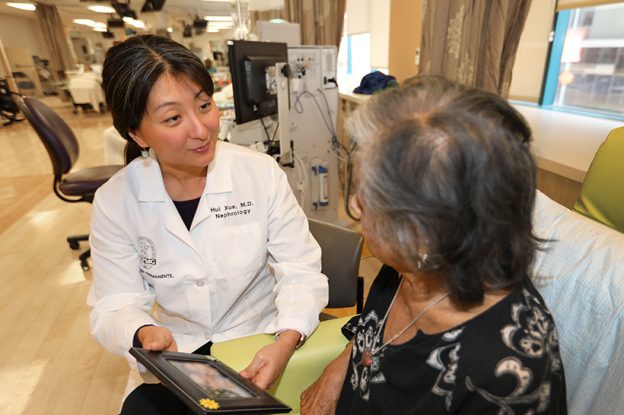
End-of-life: Researchers seek to learn needs of sickest patients
At A Glance
- Numerous researchers at R&E are working to make life transitions better for patients and their families.
- Research can give patients a broader view of their potential and possibilities at the end of life and inform the larger decisions.
Researchers at the Department of Research & Evaluation are working to make the final life transitions better for patients and their families. Using analytical analysis, interviews, data queries and more, they aim to find out what people want in their final months and days, and how to improve care during that time.
“The goal of medicine is to prevent, address, and alleviate suffering,” said Dr. Susan Wang, medical director of Life Care Planning for Kaiser Permanente Southern California. “For us to have a meaningful impact, we need more research to better understand which treatments, decisions, and services best meet the needs of our sickest patients.”
Are patients receiving the end-of-life care they want and need?
Dr. Wang, Dr. David Glass, PhD, and others conducted a study to determine how well Kaiser Permanente is meeting the health care end-of-life wishes of members in Southern California. The project started with focus groups, and then surveys with next-of-kin of members who had died.
They found that nearly 85% of the patients had talked with their loved ones about their end-of-life preferences. Almost 90% of the patients’ loved ones agreed or strongly agreed that Kaiser Permanente gave “care and treatment over the last year of my loved one’s life that met my loved one’s wishes.”
The best opportunities to even more fully fulfill patient wishes they found were to better accommodate members’ wishes to die at home and to hold more end-of-life discussions.
In a separate study, Chun Rebecca Chao, PhD, MS, is assessing end of life for patients who are ages 12 to 39 years. Her previous work found that in their final month of life, young people were receiving chemotherapy and being put into intensive care more often than older adults.
“Is it because the patient really wanted it or does the doctor feel obligated to do those things? We don’t know,” she said. “But we believe that, by understanding the end-of-life care preferences of younger patients and their caregivers, we can improve the way care is provided for this group.”
Achieving better connections in palliative care
Dr. Huong Nguyen, PhD, RN, is comparing a standard home-based palliative care model that includes routine home visits by nurses and physicians with a tech-supported model that includes video consultation with the physician. (Palliative is focused on providing relief from the symptoms and stress of a serious illness, while hospice care aims to optimize quality of life for those with limited life expectancy who are not pursuing curative treatment.)
“Video visits are not appropriate for all encounters, but we hope to better understand under what circumstances video visits are effective for patients and their caregivers,” she said.
What’s best for aging patients with chronic kidney disease?
Hui Xue, MD, MMSc, a nephrologist at the Kaiser Permanente San Diego Medical Center and a clinician investigator with R&E, is studying patients who are 75 years of age and older in the final stages of chronic kidney disease. She wants to know, does dialysis prolong their lives, and at what cost to their quality of life?
Initial findings showed that with quality of life considered, these patients gained about 7 months by being on dialysis but had more emergency department visits and hospital admissions. “Overall, it seemed like they had a harder life,” Dr. Xue said.
Research can give patients a broader view of their potential and possibilities at the end of life, provide a more holistic view of what is ahead, and inform the larger decisions.
“Ultimately, the biggest questions people have are how long are they going to live,” she said, “and how are they going to spend those days?”
_________
To read the full article, please check out the Department of Research & Evaluation’s 2018 Annual Report.





